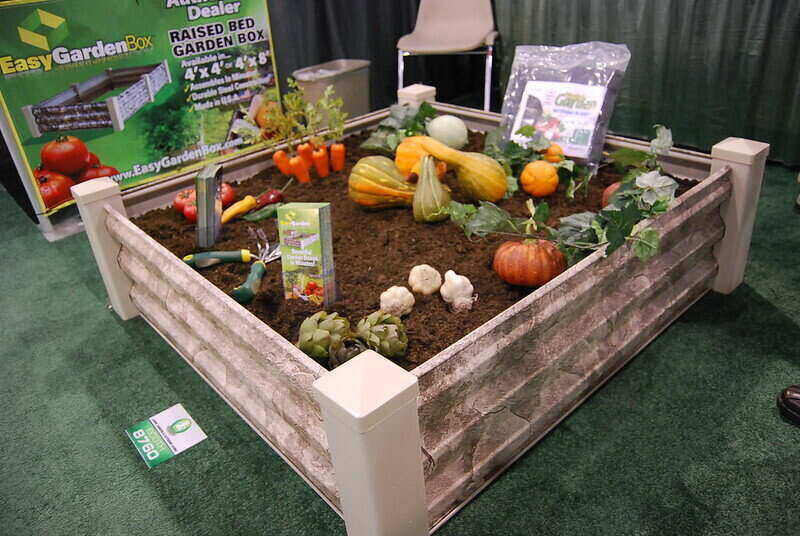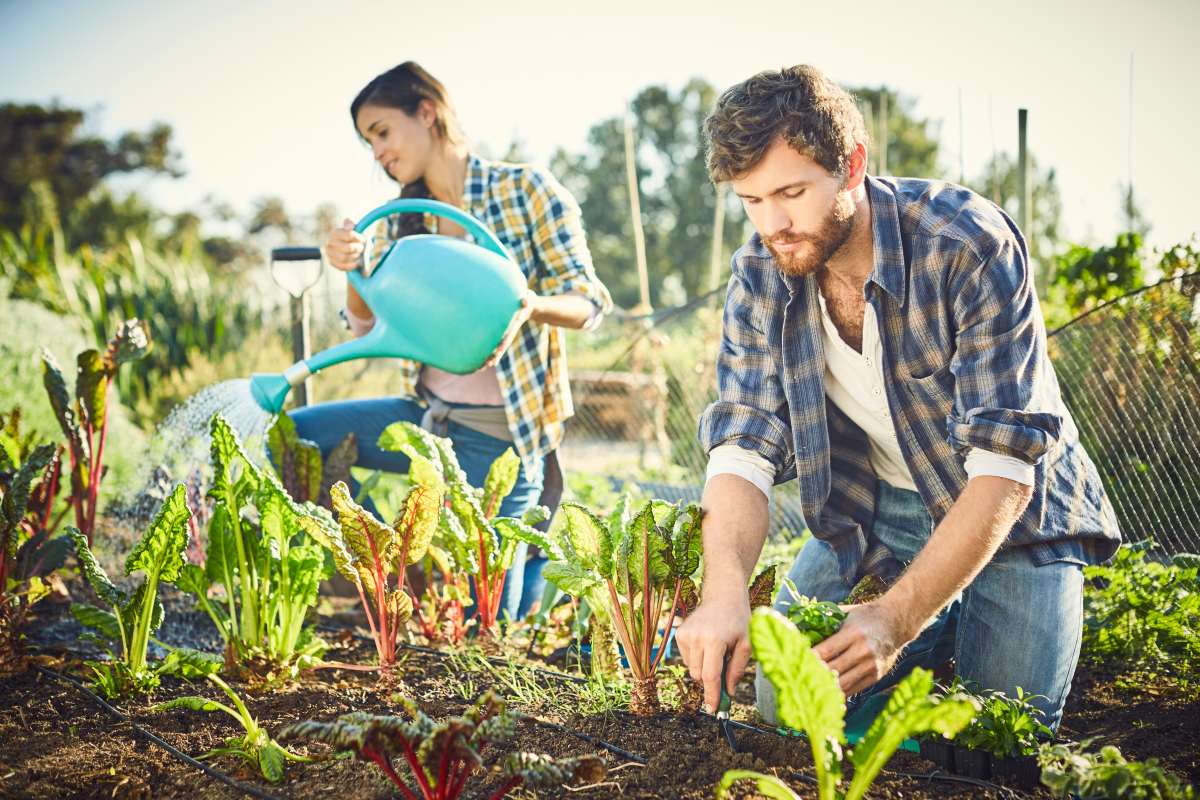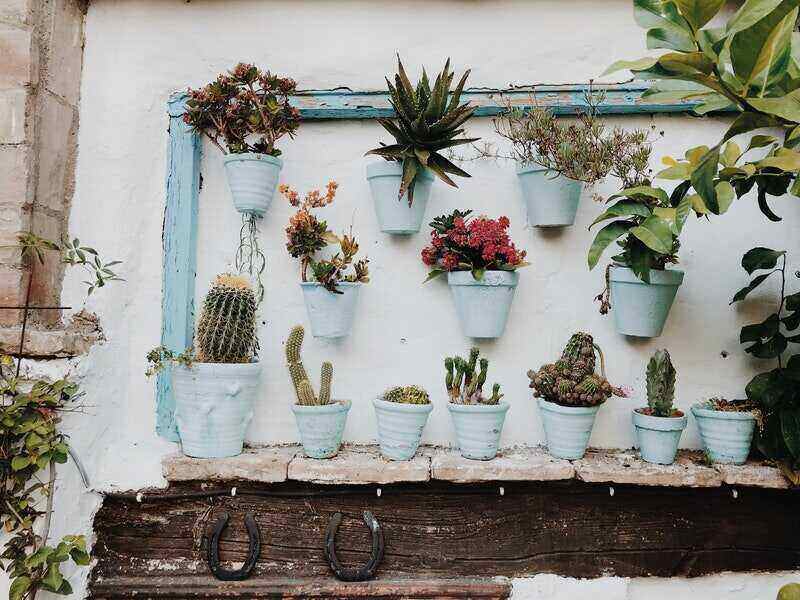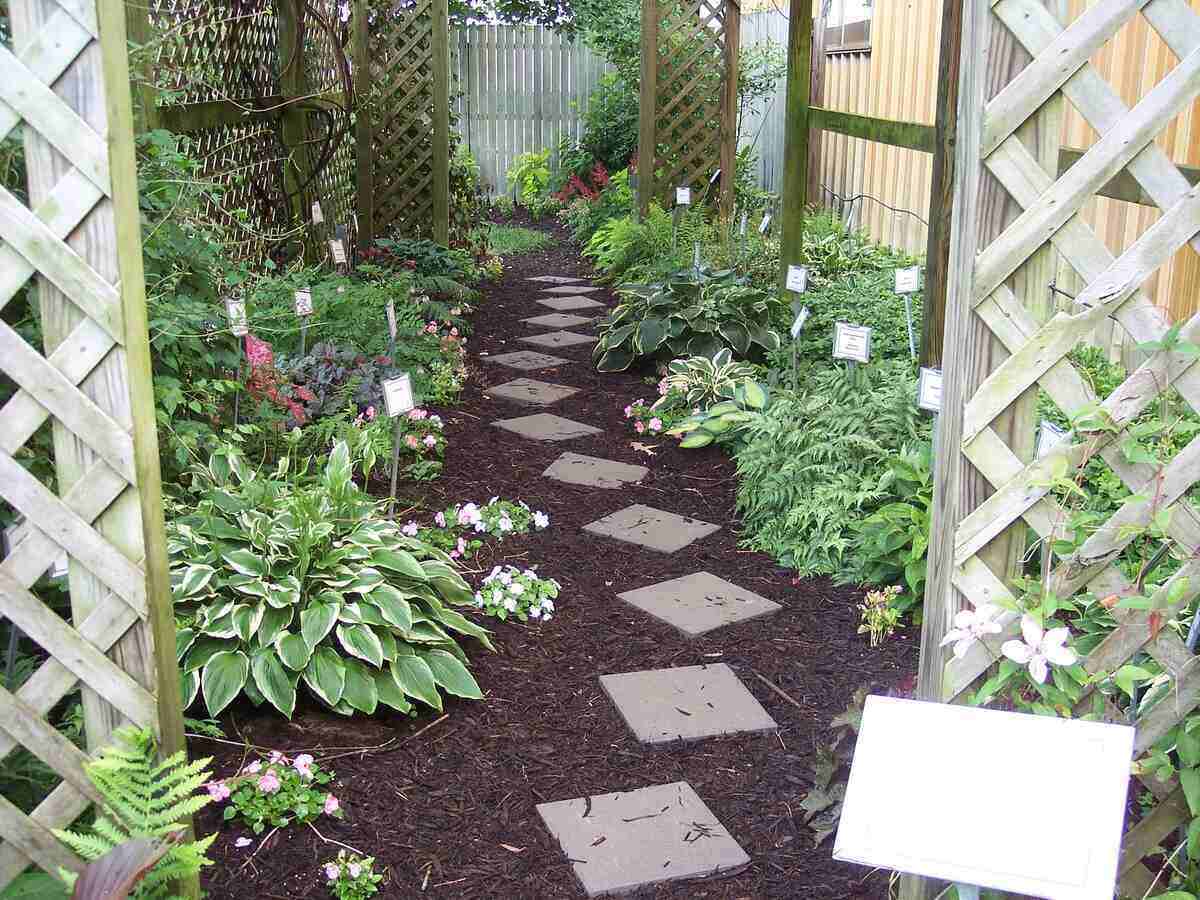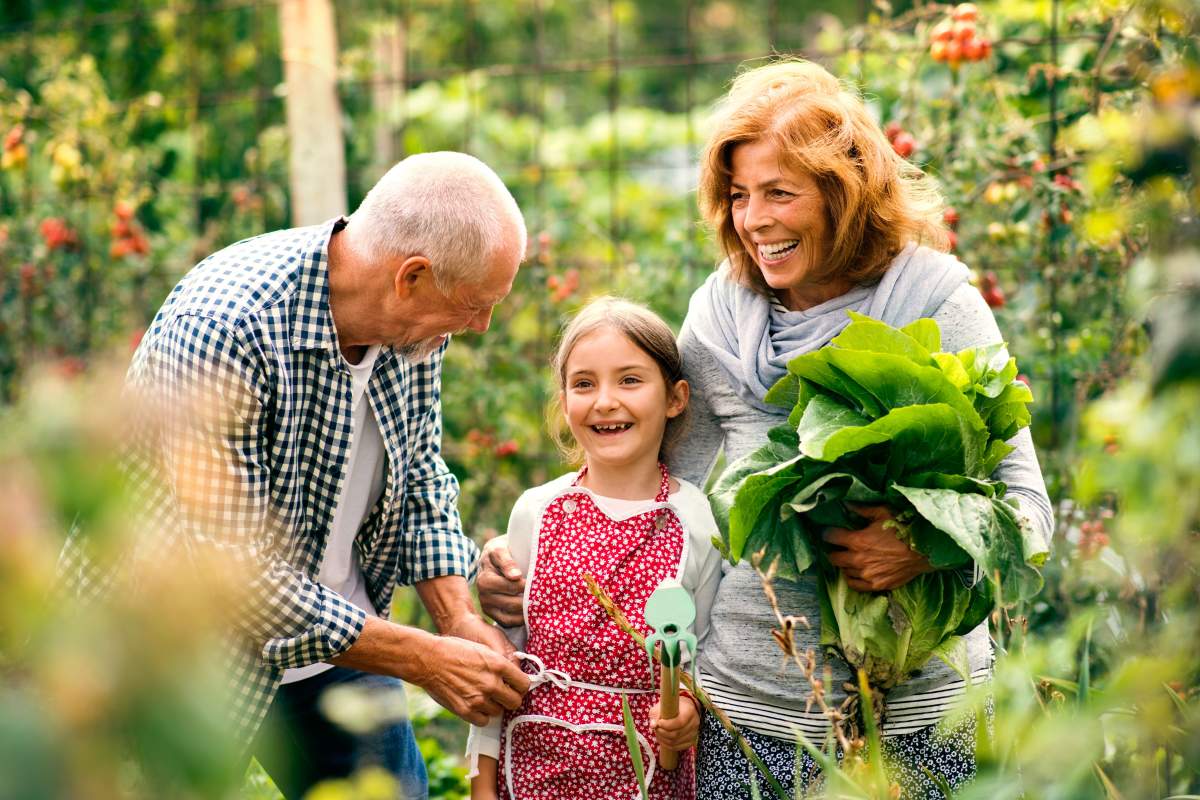
Loving fresh veggies and dreaming of a homestead garden to grow your own food in the backyard? We’re happy to help you get started! We’ve got 15 inspiring backyard vegetable garden ideas right here.
Use these ideas as a jumping-off point to decide on a good layout for you, how to start as a beginner, how to deal with a small space, how to integrate veggies into an already-designed backyard, and many other examples to draw on.
- 1. Simplest Raised Bed Idea for Beginner Gardeners
- 2. Veggiefy Your Balcony With a Container Garden
- 3. Grow Up With Planter Walls in a Small Space
- 4. Fragrant Herb Garden in a Minimalistic Landscape
- 5. Salad Garden for Veggie Lovers
- 6. A Salsa Garden for Taco Tuesdays
- 7. Root Vegetable Garden for Rich Fall Recipes
- 8. Spice Up Your Flower Garden With Some Veggies
- 9. Pair Up Friendly Veggies Together
- 10. Design a Drought-Resistant Vegetable Garden
- 11. Make It a Pizza Veggie Garden
- 12. A Greenhouse For Your Mornings
- 13. Integrate Succession Planting in Your Design Ideas
- 14. Hanging Gutter Garden for Porches and Pergolas
- 15. Use Elevated Beds for Accessible Gardening
- FAQ
1. Simplest Raised Bed Idea for Beginner Gardeners
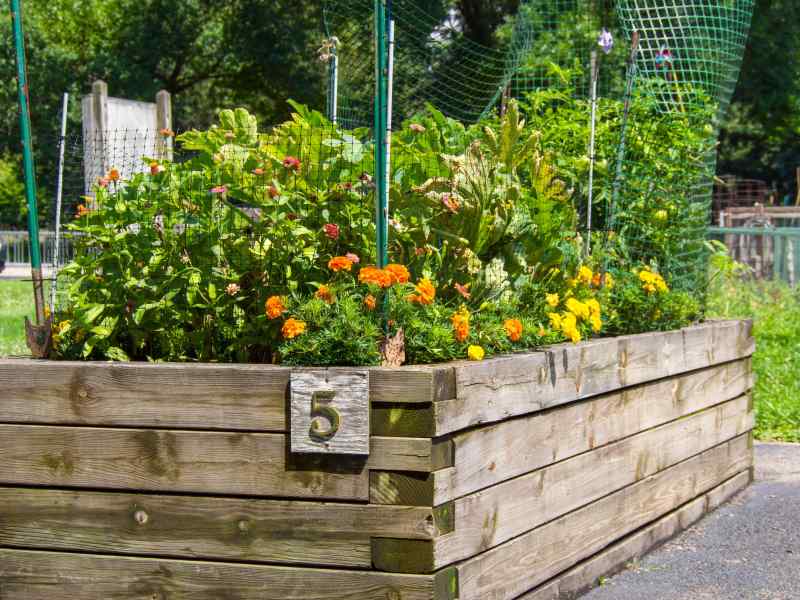
Dipping a finger into the water is always wise before jumping into the sea. Do the same with your gardening project. Start your vegetable garden with a small 4×4-foot raised bed and grow just 1 or 2 veggies or herbs to test your green thumb, patience, and determination.
Why start with a raised bed garden? Raised beds are more comfortable to work with and allow you to avoid amending the soil in this first year. You’ll add good quality garden soil to fill up the raised bed, and that’s what you’ll plant your veggies in.
Among the best vegetables to try out as a novice gardener are leafy greens (i.e. lettuce, spinach, Swiss chard), peas, kale, tomatoes, peppers, cucumbers, zucchini, and squash. Root vegetables like carrots, beets, and radishes also grow well in raised garden beds.
As a beginner, it’s easier to build your first raised bed with a kit. A raised garden bed kit costs between about $100 and $200 and can be made of wood, composite wood, PVC, or galvanized steel. You can also build a raised garden bed DIY if you’re on a budget, handy with tools, and have some wood pallets laying around.
2. Veggiefy Your Balcony With a Container Garden
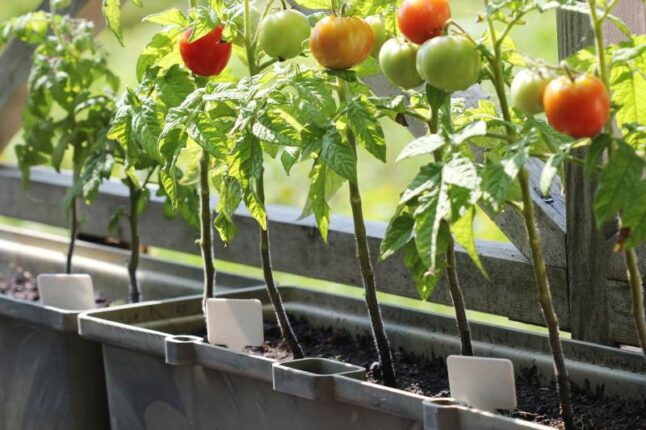
You can grow your own food even if you live in a small condo or apartment, and the only space available for gardening is your balcony. As long as plants get at least 6 hours of full sun daily, a few suitable pots can grow fresh vegetables and herbs just like traditional garden beds.
Choose suitable container sizes for the plants you want to grow in your balcony garden. They need plenty of space to stretch their roots and spread their stems and leaves. For example, cherry tomatoes need a pot at least 12 inches deep and 12 inches wide, while chives grow best in a container 6 to 8 inches wide and at least 6 inches deep.
Railing planters are an excellent option to extend your garden outside the balcony. They’re typically small but excellent for herbs and leafy crops. Here are a few practical and good-looking container models you can work with:
- Whiskey Barrel Planters with Drainage Holes & Saucer (Amazon)
- 27 in. White Resin Beadboard Deck Rail Planter (Home Depot)
- 24-in W x 31-in H Green Metal Raised Planter Box (Lowe’s)
Learn more about choosing the right pots and soil and caring for your balcony plants from our guide to container gardening.
3. Grow Up With Planter Walls in a Small Space
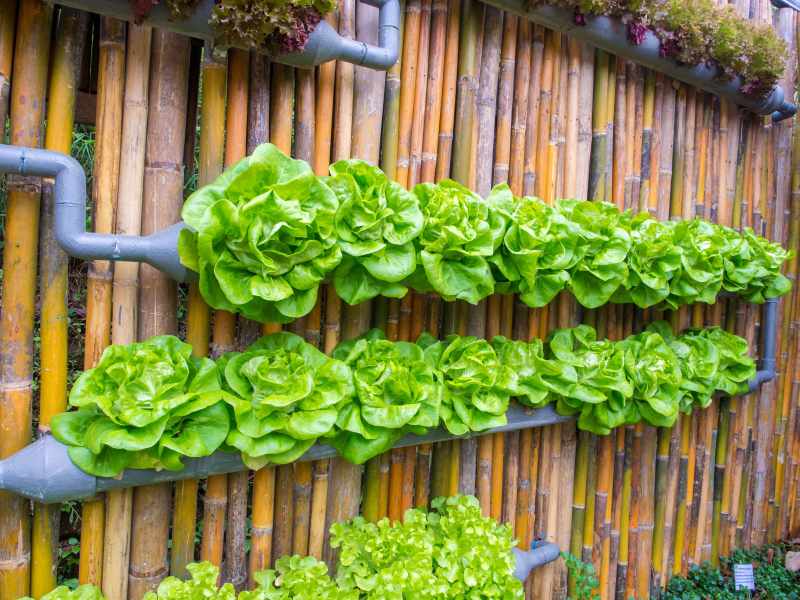
Some backyards are so small that setting up a traditional vegetable garden is almost impossible. But there’s always a way to grow your vegetables with a bit of creative thinking. If the only space you’ve got is a 1- or 2-foot wide band of soil around your yard, max it out with a vertical garden.
Start from the ground, and don’t waste an inch of soil. Install raised vegetable beds for tomato plants, peppers, and eggplants. Plant cucumbers, zucchini, or peas in the corners and install trellises for them to climb. Then, attach planters or planting bags on the wall or fence for leafy greens and herbs. Ensure all the plants receive enough sunlight.
Read our Vertical Gardening Ideas article to discover more creative ways to make room for growing veggies, herbs, and flowers in a small space.
4. Fragrant Herb Garden in a Minimalistic Landscape
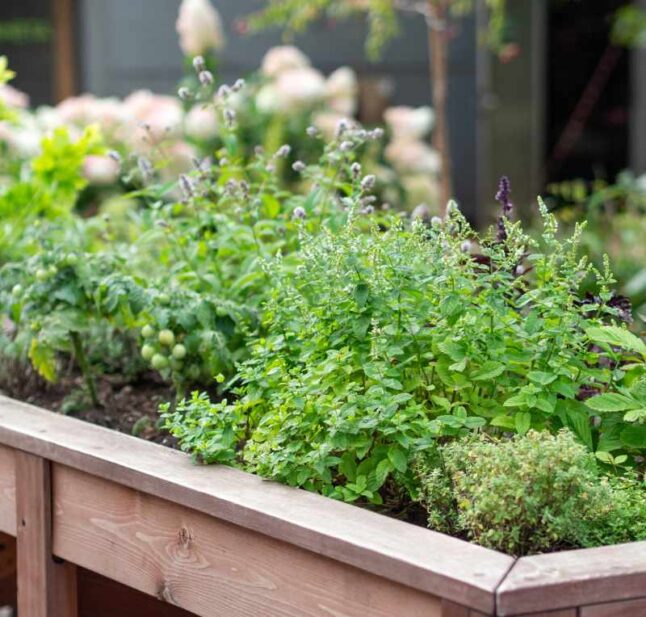
Can you integrate a kitchen herb garden into your neat, minimalist yard layout without blowing the design up? Oh, yes, it’s possible. Build tall 3×3 or 4×4-foot raised beds as you would for planting flowers. Make them square, round, or triangular. Choose a shape to fit your garden’s design. Use the beds to grow fragrant herbs like thyme, sage, coriander, parsley, mint, lavender, and rosemary.
Mixing the different heights, shapes, and leaf textures will blow your mind. Herbs look exquisite and neat. As elegant as any ornamental. Their small, edible flowers add a tint of delicate color in the summer.
Choose a suitable material for edging the beds, like bricks or redwood, to contrast the other materials in your landscape design.
5. Salad Garden for Veggie Lovers
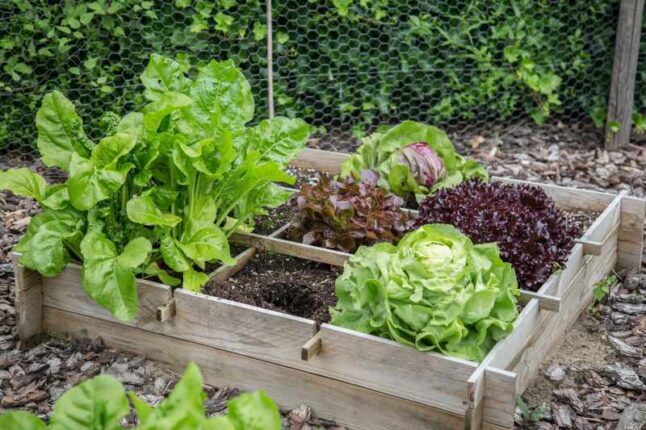
A salad a day keeps the doctor away! Fresh, homegrown vegetables in a delicious daily salad give your body valuable fiber, minerals, and vitamins. Make a list of your favorite salad ingredients and start growing them in your garden. You don’t need much space.
Spinach (Go, Popeye!), radishes, carrots, lettuce, Swiss chard, and green onions only need a small area to grow. Tomatoes, peppers, and cucumbers can be managed with trellises and cages.
Most leafy greens are cut-and-come-again veggies, so a few plants will feed you for a long time. Radishes and carrots can only be harvested once, so you’ll need to plant more of those. Tomatoes, peppers, and cucumbers fruit repeatedly during their growing season. Two or three plants are typically enough for a small family. Here are a few delicious veggie salad ideas to inspire and motivate you!
6. A Salsa Garden for Taco Tuesdays
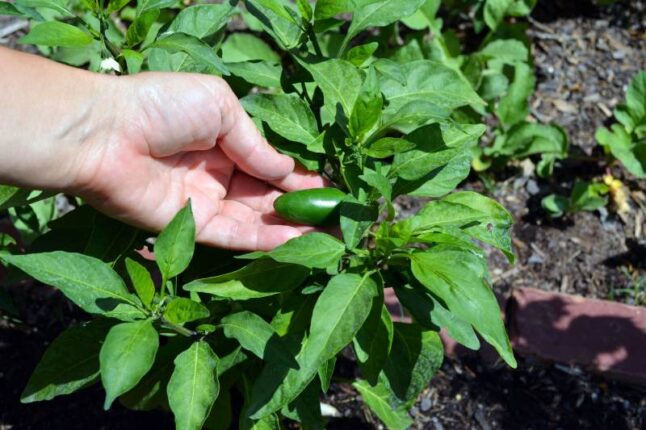
There’s no lack of vegetable garden ideas for cooking aficionados. This is a golden one for taco and salsa fans! Set aside a veggie bed for your salsa ingredients. Plant tomatoes, tomatillos, cilantro, onions, garlic, and peppers (jalapenos, serranos, arbor chiles, or your other favorites).
Add a lime tree to grow in a large terracotta pot, and you’re all set. You’ll never want grocery-store salsa again once you make your own with fresh veggies from your own backyard!
7. Root Vegetable Garden for Rich Fall Recipes
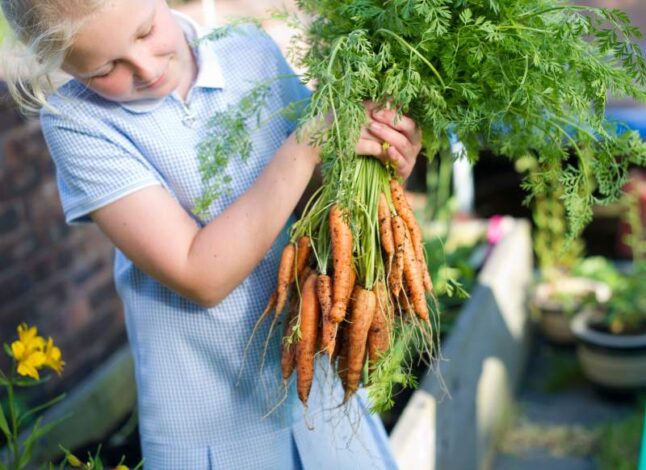
Radishes, carrots, turnips, parsnips, root celery, potatoes, sweet potatoes, and beets are the most popular (and delicious!) root vegetables any gardener can easily grow. They can be harvested only once. You’ll need a lot of space if you’re growing them for a large family or plan to share the goodies with relatives and friends.
On the other hand, most of them have two growing seasons, spring and fall, maximizing your yearly yield. And you can grow them from scraps to save money on seeds.
To dig out full, tender, beautiful root veggies, plant them in in-ground beds only if you have loose, sandy soil. Otherwise, install raised beds tall enough to fit their root depth. Raised beds also help keep out the usual garden thieves, like rabbits and gophers.
8. Spice Up Your Flower Garden With Some Veggies

Are you considering adding veggies to your front yard but worried about ruining the landscape design? Mix the veggies in with your ornamentals! This method is called interplanting and comes with huge aesthetic and practical benefits. Flowering plants attract pollinators and other beneficial insects, keep pests away, and protect the soil from sun and evaporation.
Plant some kale or broccoli in your echinacea plot. They’ll make for a beautiful contrast. Add dill, climbing cucumbers, and zucchini in the back of your flower beds for structure and volume. Pair these with sunflowers, wild poppies, or lilies. Add tomato plants and peppers with your marigolds and zinnias.
Pro tip: To make your colorful landscape double as a 100% edible garden, focus on edible flowers. Some of the most popular edible beauties are nasturtium, roses, calendula, daylily, lavender, echinacea, dandelion, and violas.
9. Pair Up Friendly Veggies Together
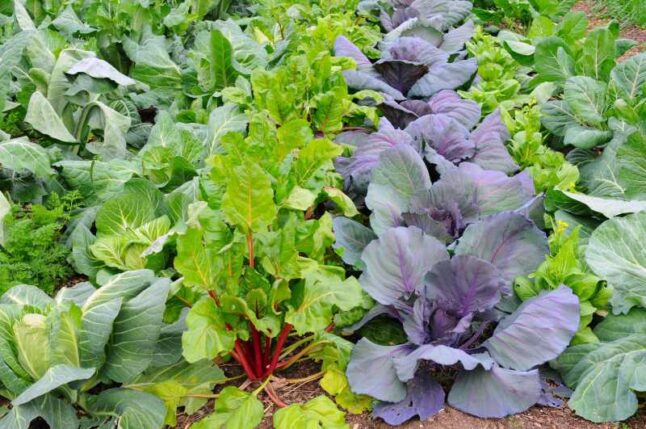
Some types of vegetable plants go well together, others not so much. Taking these friendships and animosities into consideration when designing your home garden is called companion planting. It’s kind of like planning the seating at a wedding – you want to ensure people who like each other end up at the same table and keep bitter foes as far from each other as possible.
For example, broccoli enjoys growing with celery, basil, and cucumber, but it doesn’t make a good neighbor for pumpkins, strawberries, and melons since they all use a lot of space and compete aggressively for it.
Use a companion planting chart to draw a plan for your beds on paper. Build up some zen and patience; you’ll go through many drafts until you get it right. But the result is worth it. To simplify your work, use the square-foot planting method. Divide the veggie beds into 1 square foot sections and place plants in each section according to their need for space and companionship rules.
Pro tip: One of the lowest maintenance companion planting methods that yields tons of food is called Three Sisters Gardening. This method is based on ancient Native American agricultural practices, and it employs squash, pole beans, and corn (the “three sisters”).
10. Design a Drought-Resistant Vegetable Garden
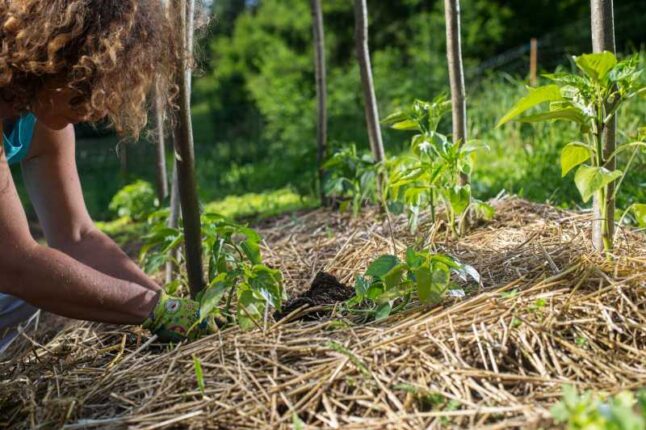
With hotter and drier summers, setting up a vegetable garden layout that supports plants during drought is essential. Start by amending the soil with organic matter to improve its water-holding capacity.
If you have enough space, build or buy a compost bin and start composting to make your own soil amendments for the next growing season. Here are a few popular bin models home gardeners use:
- Compost Tumbler Bin Composter Dual Chamber 43 Gallon (Amazon)
- Tumbling Composter with Two Chambers for Efficient Batch Composting (Home Depot)
- 18.5 Plastic Tumbler Composter (Lowe’s)
Plant your veggies in in-ground beds. They offer better insulation during high heat than raised beds. Upgrade those in-ground beds by covering the soil surface with mulch after planting the veggies. It reduces evaporation and keeps the soil temperature lower.
11. Make It a Pizza Veggie Garden
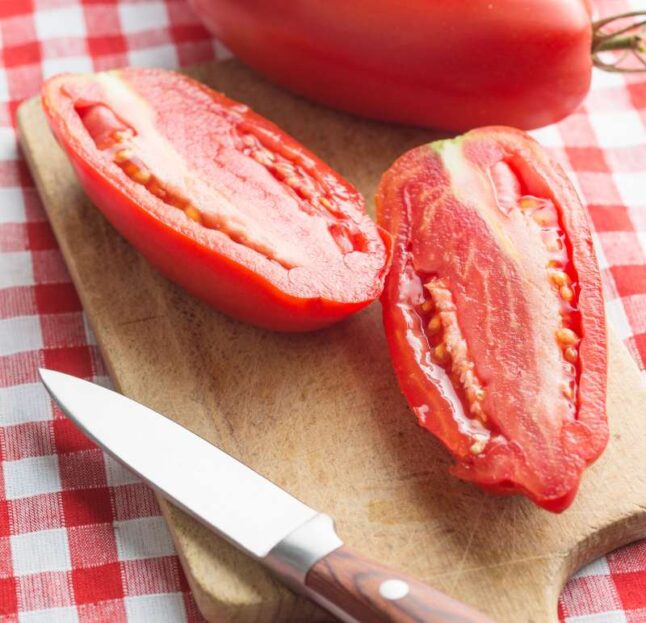
Let your favorite foods inspire the gardener in you! If you’re a pizza lover, dedicate your small vegetable garden to ingredients for homemade pizza recipes. Plant several tomato varieties to make the best pizza sauce, full of juice and flavor. San Marzano and plum tomatoes are two of the most recommended for sauces.
Add basil, cilantro, oregano, and other pizza herbs you enjoy in your sauce or as toppings. Plant some arugula to sprinkle its playful leaves across the melted mozzarella.
12. A Greenhouse For Your Mornings
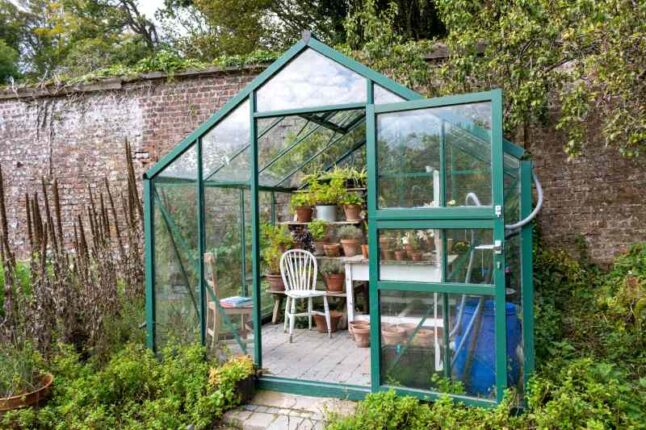
Whether you build a DIY polytunnel or buy a glass or polycarbonate greenhouse, covered spaces can do wonders for your vegetable gardening. You can start your vegetables from seed early in the spring and save transplant money. A greenhouse also allows you to extend the growing season until late in the fall and grow varieties that need a warmer climate than the one you live in.
Pro tip: If there’s space, include a small coffee table and seating, and enjoy your morning coffee or tea inside the greenhouse during cold fall and spring mornings. It’s important to enjoy your garden rather than seeing it as another house chore to manage.
13. Integrate Succession Planting in Your Design Ideas
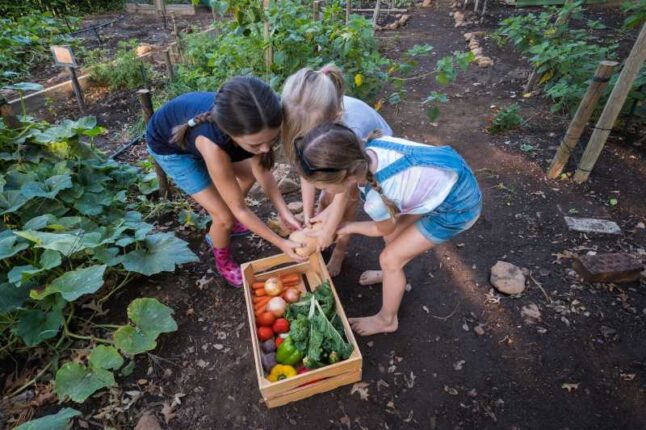
Succession planting is a method that allows you to maximize the crops in your kitchen garden by alternating veggies with different growing seasons. In the spring, you plant radishes, lettuce, spinach, carrots, kale, peas, and other cool-season vegetables.
Come summer, you harvest all of them and plant warm-season vegetables on the same plot. Tomatoes, peppers, cucumbers, zucchini, squash, pumpkins, beans, and eggplants need summer heat to grow well and take their fruit to maturity.
You’ll need a planting calendar and two garden charts for succession planting: one with the spring-fall layout and one with the placement of your summer vegetables. Remember that summer veggies are taller and broader and need trellises, arbors, or other support structures to help them grow.
Here are some examples of supporting structures to use with your tall summer veggies:
- Garden Obelisk Trellis (Amazon)
- White Vinyl PVC Cambridge Trellis (Home Depot)
- Arbor Trellis for Climbing Plants (Walmart)
14. Hanging Gutter Garden for Porches and Pergolas
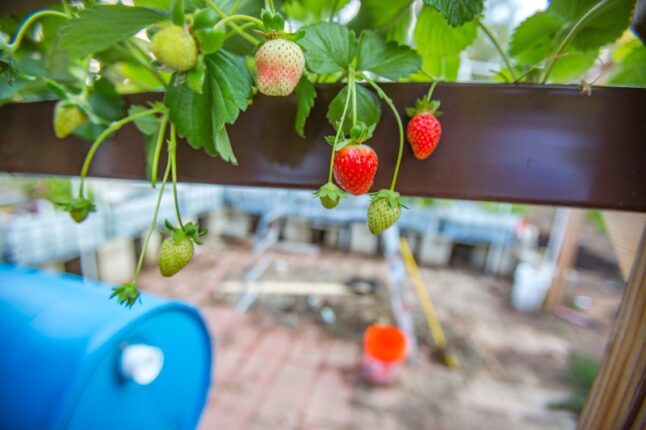
Tiered PVC gutter gardens make practical, easy-to-use garden containers. Hang them on the porch with chains and steel rods. Use them to plant aromatic herbs, leafy green, leeks, strawberries, radishes, or garlic.
A hanging gutter garden fits perfectly on the side of a pergola meant for serving dinner or built as a summer cooking area. Use its space to plant some lavender and mint that keep insects at bay.
Pro tip: You can also plant vine vegetables like cucumbers and beans in containers around a pergola and guide them to climb onto its roof.
15. Use Elevated Beds for Accessible Gardening
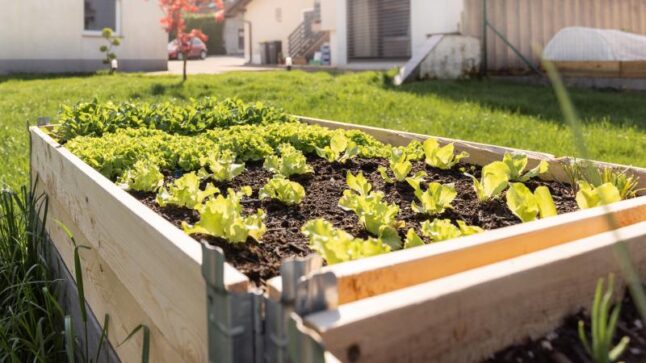
Elevated beds are large planting boxes on legs, typically built from wood or plastic. They are smaller than in-ground and raised beds and are also typically mobile. You can move them from one corner of the garden to another. For example, you can change their place in late summer, when you seed the fall crops, to an area that receives more sun in the cool season.
They are a great option for people in wheelchairs or if you’ve got back problems and should avoid bending over low planting beds for too long. Also, consider elevated beds in a garden that’s prone to flooding.
However, plastic or galvanized steel models might be better than wood. Elevated beds with wooden legs exposed repeatedly to moisture tend to rot and give in under the weight of the soil and plants.
FAQ About Vegetable Gardening
How Many Vegetables Can I Plant in a Vegetable Garden?
In a 10×10 square foot garden, you can plant between 9 and 25 vegetables, depending on the type and space required at maturity.
What Are Some Simple And Cheap Ways to Grow Vegetables?
Growing veggies doesn’t have to be expensive. Here are some simple ways to grow vegetables in your garden with a low budget:
- Start your plants from seed instead of buying vegetable transplants.
- Keep the seeds from your crops to avoid buying them the next year.
- Instead of buying pots for germinating your seedlings, use yogurt or clamshell containers, egg cartons, or styrofoam meat trays.
- Convert buckets and plastic woven shopping bags into containers for growing veggies to maturity.
- Build your raised beds from pallet wood or stone.
- Make your own compost out of kitchen scraps and yard trimmings.
- Get free manure from a nearby farm instead of buying fertilizer.
- Use dry leaves and grass clippings as free mulch.
- Collect rainwater in a rain barrel or other rainwater harvesting system (but first, check restrictions and incentives in your state).
What Is a Good Layout For a Vegetable Garden?
A good layout for your vegetable garden is building 4×4 or 4×8-foot beds and layering the plants by height. Plant the tallest veggies on the northern side, the smallest on the south side, and the rest in the middle to ensure all receive the most sun exposure possible.
What Is a Good Way to Grow Vegetables in a Small Space?
To make the most of a small space, grow more rounds of vegetables in the same spot by using succession planting. Climb vine vegetables, like cucumbers and beans, on trellises or arbors, and enclose wide ones, like tomatoes and zucchini, in vertical cages. Install hanging bags or containers and use the vertical space for growing herbs.
How to Start a Vegetable Garden?
Planning the garden layout is an essential first step in starting a garden. Now you know what veggies and herbs you can grow and where. Next, prepare the garden beds, trellises, and cages, suspended containers, and other necessary structures. Install and test the watering system. Seed and plant seedlings. Water the soil and keep it moist for a couple of weeks until your plants develop proper roots.
How Often to Water Your Garden?
Water your vegetables a few times a week during seed germination and transplant rooting to keep the soil moist. Most established vegetable plants grow well with 1 to 2 inches of water per week applied in one to three sessions. Increase or decrease the watering frequency depending on soil type, rainfall, and temperature.
Design Your Dream Veggie Garden Today!
A well-designed vegetable garden can be a gorgeous addition to your yard. Contact a local landscaper to help you choose a garden layout that fits your space the best. LawnStarter can put you in contact with amazing, talented landscaping pros across the country. Use their expertise and your own creative vision to design your dream veggie garden today!
Main Photo Credit: halfpoint / Canva Pro / License
